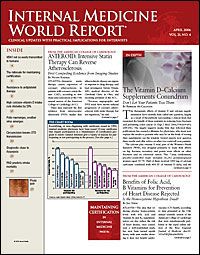Publication
Article
Internal Medicine World Report
For Men, Easiest Osteoporosis Screening Tool Is Best
SAN DIEGO—Dual-energy x-ray absorptiometry (DEXA) is a valuable screening tool for osteoporosis. While many methods have been validated for determining which women should be referred for the cost-effective DEXA scanning, men have been mostly ?overlooked in clinical trials.
Bryan Whelan, MD, of Cork Uni?versity Hospital, Cork, Ireland, and colleagues assessed 4 commonly used screening tools for osteoporosis: the Osteoporosis Self-Assessment Tool (OST), the Simple Calculated Osteo?porosis Risk Estimation (SCORE), the Osteoporosis Risk Assessment Index (ORAI), and the Study of Osteoporotic Fractures Simple Useful Risk Factors (SOFSURF).
They presented their study results at the recent annual meeting of the American College of Rheumatology, showing that the OST was best for osteoporosis screening in men for determining the need for DEXA scanning. A previous study (Mayo Clin Proc. 2003;78:723-727), demonstrated that OST screening was an easy and effective way of predicting osteoporosis in men, as defined by DEXA measurements.
In this new study, 600 Irish men were selected from a group of patients who had been referred for bone mineral density (BMD) assessment over a 5-year period. Each of the 4 screening tools was applied to determine their usefulness overall and in specific age-groups based on clinical data in predicting a T score of 2.5 at the femoral neck, total hip, and lumbar spine individually, as well as at any site using receiver-operating characteristic curves.
Unlike the other tools, the calculation of the OST was simple, based solely on age and weight, and was highly predictive across the range of sites. Regardless of age-group, “the OST comes out on top,” Dr Whelan said.
Area under the curve (AUC) was the primary outcome measure. OST had the highest mean AUC of the 4 tools, although it was not significantly higher than the other tools. It proved most accurate for men >70 years and for predicting a T score of 2.5 at the femoral neck.
OST cutoff scores were chosen to give a sensitivity of approximately 90% with maximal specificity. Using cutoff scores of +10, +6, +2, and +8 for men aged 30 to 50 years, 50 to 70 years, >70 years, and all ages, respectively, achieved sensitivities of 90% to 92%.
The specificity was fairly low, ranging from 29% to 41%, depending on age-group. The other tests scored well for specific sites and age-groups. For the OST, “we suggest a cutoff score in our population of +2 be used in men over 70 years,” Dr Whelan said.—D.M.K.






